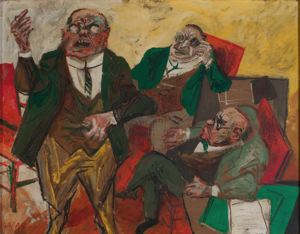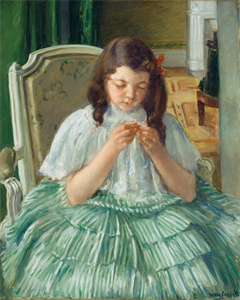Object Results
| Showing 1 of 1 |
|

William Gropper
American, 1897–1977
William Gropper was one of the most prominent social activist artists of the mid-twentieth century. His childhood as the son of Jewish immigrants in New York’s impoverished Lower East Side engendered a deep compassion for the disenfranchised. The subjects of his cartoons, and his later paintings and drawings, were taken from his own experience of discrimination, corruption and poverty, particularly in the darkest days of the Great Depression.
Gropper left school at fourteen to help earn a living for his family by working in a clothing store. His sole escape was drawing and his most important art training came between the years 1912 and 1915, when he studied with the painters George Bellows (1882–1925) and Robert Henri (1865–1929) at the progressive Ferrer Center. His skills won him a scholarship to the National Academy of Design when he was nineteen. The New York Tribune hired Gropper as an illustrator about 1919, and he later contributed illustrations and satirical cartoons to other periodicals such as Vanity Fair and the leftist publication The New Masses. It was in his role as a cartoonist/commentator that he earned his living throughout the 1920s and 1930s, creating paintings privately until he was awarded public mural commissions with the Treasury Relief Project during the New Deal period.
In his work as a political cartoonist the artist was a close observer of the federal government in Washington, D.C. He adopted situations and personalities associated with the United States Senate as one of the major themes of his work, reprising the topic of the corrupt politician throughout his career. (One of his key works in a public collection is titled The Senate, 1935, at the Museum of Modern Art in New York.) Because of his activities as a labor organizer and his frank portrayal of societal ills, the artist was blacklisted by the House Un-American Activities Committee in 1953. Caucus, created in that decade, is a work related to this series of depictions of politicians, who Gropper held responsible for the failure of the United States government to create a more equitable society.
In the tradition of the French nineteenth-century cartoonist, Honore Daumier (1808–1879), Gropper caricatured the establishment figures he represented, depicting them as physically distorted, and at times gruesome, as a method of conveying their dissipation and self-absorbed apathy in the face of human tragedy. In Caucus, the orator gestures with claw-like hands, his face disfigured by a grimace displaying sharp teeth and the vacant stare produced by the reflection of his glasses. His audience of fellow politicians appears equally grotesque, pompous, and complicit in the failure to legislate social reform. The gestural application of the paint combined with the flattened space surrounding the figures suggest a modernist’s approach to design which was much in keeping with Gropper’s significant experience as a graphic artist.
American, 1897–1977
Caucus
about 1955-1958
Object Type:
Painting
Dimensions:
16 3/4 x 21 1/4 in. (42.55 x 53.98 cm)
Medium and Support:
Oil on paperboard
Accession Number:
2018.0010.0007
Credit Line:
Gift of Babette L. Wampold in memory of Charles H. Wampold
Currently On View
William Gropper was one of the most prominent social activist artists of the mid-twentieth century. His childhood as the son of Jewish immigrants in New York’s impoverished Lower East Side engendered a deep compassion for the disenfranchised. The subjects of his cartoons, and his later paintings and drawings, were taken from his own experience of discrimination, corruption and poverty, particularly in the darkest days of the Great Depression.
Gropper left school at fourteen to help earn a living for his family by working in a clothing store. His sole escape was drawing and his most important art training came between the years 1912 and 1915, when he studied with the painters George Bellows (1882–1925) and Robert Henri (1865–1929) at the progressive Ferrer Center. His skills won him a scholarship to the National Academy of Design when he was nineteen. The New York Tribune hired Gropper as an illustrator about 1919, and he later contributed illustrations and satirical cartoons to other periodicals such as Vanity Fair and the leftist publication The New Masses. It was in his role as a cartoonist/commentator that he earned his living throughout the 1920s and 1930s, creating paintings privately until he was awarded public mural commissions with the Treasury Relief Project during the New Deal period.
In his work as a political cartoonist the artist was a close observer of the federal government in Washington, D.C. He adopted situations and personalities associated with the United States Senate as one of the major themes of his work, reprising the topic of the corrupt politician throughout his career. (One of his key works in a public collection is titled The Senate, 1935, at the Museum of Modern Art in New York.) Because of his activities as a labor organizer and his frank portrayal of societal ills, the artist was blacklisted by the House Un-American Activities Committee in 1953. Caucus, created in that decade, is a work related to this series of depictions of politicians, who Gropper held responsible for the failure of the United States government to create a more equitable society.
In the tradition of the French nineteenth-century cartoonist, Honore Daumier (1808–1879), Gropper caricatured the establishment figures he represented, depicting them as physically distorted, and at times gruesome, as a method of conveying their dissipation and self-absorbed apathy in the face of human tragedy. In Caucus, the orator gestures with claw-like hands, his face disfigured by a grimace displaying sharp teeth and the vacant stare produced by the reflection of his glasses. His audience of fellow politicians appears equally grotesque, pompous, and complicit in the failure to legislate social reform. The gestural application of the paint combined with the flattened space surrounding the figures suggest a modernist’s approach to design which was much in keeping with Gropper’s significant experience as a graphic artist.
Keywords
Click a term to view the records with the same keyword
Portfolio List
Click a portfolio name to view all the objects in that portfolio
This object is a member of the following portfolios:
Your current search criteria is: Keyword is "S" and [Object]Display Artist is "William Gropper".
